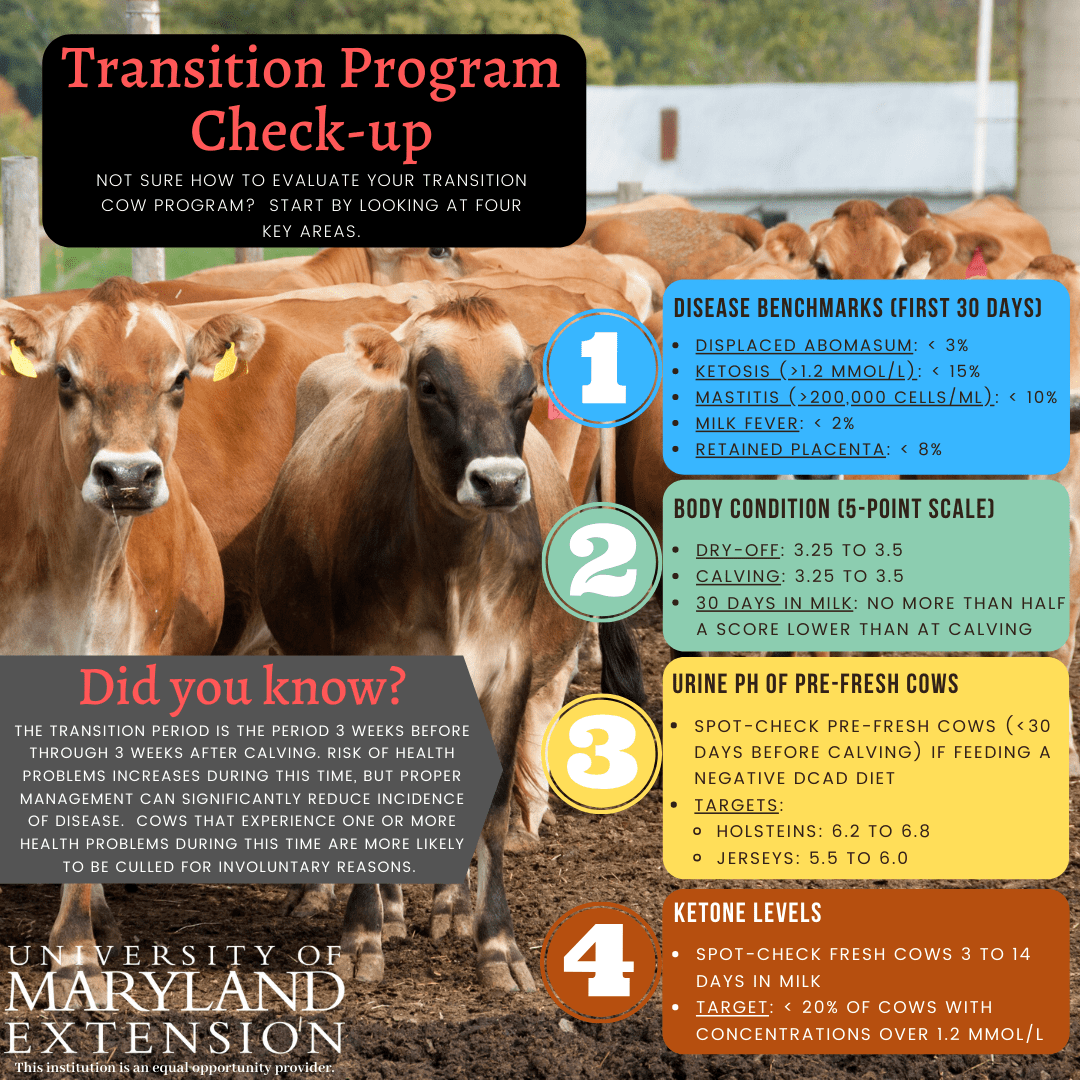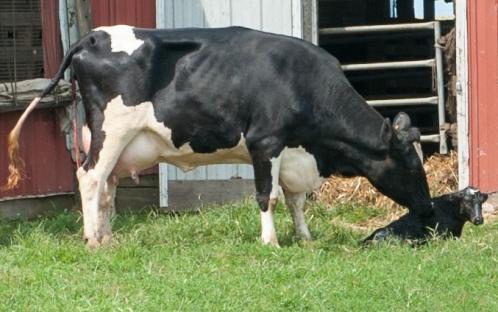What is the transition period?
The transition period is defined as the 3 weeks before calving through the 3 weeks after calving. During this time, cows “transition” from a pregnant, non-lactating state to a non-pregnant, lactating state. This event involves many coordinated physiological changes in the cow, and failure of any one of these changes to occur at the right time or in the right magnitude can be devastating. Dairy producers should strive to provide the cow with appropriate environmental conditions that maximize her chances of making the transition to lactation without complication.
Why should we pay attention to the transition period?
The success with which a cow makes the transition to lactation can have dramatic impacts on her performance during the lactation that follows. The prevalence of health disorders is greater during the transition period than at any other time during a cow’s life(1). Cows that experience one or more health disorders during the transition period are over 2 times more likely to be culled by 120 days in milk due to poor health, production, or fertility(2). These cows are also at greater risk for reduced production for that entire lactation. Thus, when the increased risk for culling, reduced production, and potential veterinary-related expenses are considered, the prevalence of health disorders during the transition period can have a substantial and prolonged economic impact. The development of a successful transition program should be of high importance for all dairies because of its implications for profitability and animal welfare.
Herd-level Assessment of the Transition Program
The old adage “you can’t fix what you don’t measure” can be applied to a wide variety of circumstances and certainly has application when it comes to managing the dairy herd. If consistent monitoring is not practiced, it will be difficult to identify areas where improvements are needed. Whether assessing an existing transition program or developing a new one, there are a few key areas that should be evaluated routinely to help pinpoint where improvements may be needed.
-
Prevalence of disease during the first 30 days in milk.
This is an area that is frequently monitored by producers. However, in order for this information to be useful, producers must have a clear definition of each disease and be diligent in recording every detected occurrence. Table 1 shows benchmarks for the prevalence of conditions that are often associated with the transition period.
Table 1. Benchmarks for incidence of various diseases during the transition period.Disease/Condition Benchmark Displaced Abomasum
< 3%
Ketosis (> 1.2 mmol/L)
< 15%
Mastitis (SCC > 200,000 cells/mL)
< 10%
Milk Fever (clinical, showing signs)
< 2%
Retained Placenta
< 8%
-
Body Condition.
Proper body condition is arguably one of the most important aspects of a successful transition program. There are three critical times when body condition should be assessed: at dry-off, at calving, and 30 days after calving. Research has shown that cows that are over-conditioned at calving or gain condition during the dry period have lower feed intake after calving and are more prone to metabolic diseases, such as ketosis3. Therefore, it is critical that cows are of appropriate body condition at dry-off and that little to no condition gain occurs during the dry period. Excessive body condition loss after calving is also problematic because this can lead to ketosis or fatty liver disease. As a rule of thumb, cows should not lose more than half a condition score during the first 30 days in milk. Table 2 shows the target body condition scores at the three critical time points. Note that body condition scores are assigned on a 1 to 5 scale, where 1 is thin and 5 is obese.
Table 2. Ideal body condition scores for dry and early lactation cows at various critical time-points.Time Point Target Body Condition Score Dry-off
3.25 to 3.5
Calving
3.25 to 3.5
30 Days in Milk
No more than half a score lower than score at calving
-
Urine pH of close-up dry cows.
The utilization of bone calcium stores to support milk calcium secretion is a normal adaptive metabolic process in mammals. However, if these metabolic processes adapt too slowly at the onset of lactation, there will not be enough free calcium in the blood to meet the calcium requirements for milk production right after calving. In such situations, blood calcium drops below “normal” levels and cows will develop milk fever. Milk fever is considered a “gateway” disease because its occurrence (clinical or subclinical) predisposes cows to other health disorders, such as mastitis and retained placenta(4). Dietary cation-anion difference (DCAD) is often used to modify the acid-base status of close-up dry cows (cows that are less than 30 days from their due date) to initiate the adaptive process by which calcium is released from bone. Initiation of this process before calving by feeding a negative DCAD diet has been shown to reduce incidence of milk fever after calving. To assess the effectiveness of the close-up diet to initiate this process, the urine pH of the close-up cows should be examined periodically. Urine pH values of 6.2 to 6.8 for Holsteins (or 5.5 to 6.0 for Jerseys) are indicative of an effective negative-DCAD close-up diet(4).
-
Ketone levels.
Urine, blood, or milk ketone concentrations are used as indicators for ketosis, a metabolic disorder that occurs when cows utilize excessive amounts of body fat in a short period of time. Approximately 30% of cows will develop ketosis during the early lactation period, and only a small portion of those will display clinical signs of the disease(5). The presence of ketosis can be determined on-farm by measuring the ketone concentrations in blood, milk, or urine. Blood ketone concentration can be measured quantitatively using a digital meter (such as Precision Xtra meter®) and milk and urine ketone concentrations can be measured qualitatively using color-changing dipstick test strips (such as Ketostix®). Both tests are fairly inexpensive: the digital meter costs $30 plus $1.08 per test strip and the dipstick test strips generally cost around $0.30 per test. Herd-level presence of ketosis should be evaluated before deciding if frequent testing of individual cows is necessary. For a herd-level assessment, ketone concentrations for a sample of cows that are 3 to 14 days in milk should be evaluated6. If 15 to 40% of the cows in the sample have blood ketone concentrations greater than 1.2 mmol/L (or 15 mg/dL in urine using the dipstick test) then it is recommended that all fresh cows (3 to 14 days in milk) be evaluated twice weekly. Cows should be treated with oral administration of propylene glycol if blood ketone levels are greater than 1.2 mmol/L (or 15 mg/dL in urine using the dipstick test)(6).
Monitoring Individual Cows
While evaluation of the transition program as a whole helps to identify areas where management can be improved, it is still important to monitor individual cows during this time to ensure that prompt and appropriate intervention occurs when it is needed. In addition to the typical daily observations that should occur for all cows on the farm (milk production, presence of mastitis, behavior), rectal temperature and the presence of abnormal discharge from the vulva should also be evaluated daily during the first 10 days after calving to detect early indicators of infection. The temperature should be taken at the same time each day, ideally in the morning to reduce the potential influence of outside temperatures. Normal body temperature is between 101 and 103°F.
Conclusion
Routine monitoring of the transition cow is important for keeping cows healthy and productive. This practice also generates data which is useful in evaluating and improving the transition program. The development of a successful transition program should be of high importance for all dairies because of its implications for profitability and animal welfare.
Printer Friendly Version More Dairy Resources

References
1Goff, J. P., and R.L. Horst. 1997. Physiological changes at parturition and their relationship to metabolic disorders. J. Dairy Sci. 80:1260–1268.
2Probo, M., O.B. Pascottini, S. LeBlanc, G. Opsomer, and M. Hostens. 2018. Association between metabolic diseases and the culling risk of high-yielding dairy cows in a transition management facility using survival and decision tree analysis. J. Dairy Sci. 101: 9419–9429.
3Roche, J. R., N.C. Friggens, J.K. Kay, M.W. Fisher, K.J. Stafford, and D.P. Berry. 2009. Invited review: Body condition score and its association with dairy cow productivity, health, and welfare. J. Dairy Sci. 92:5769–5801.
4Goff, J. P. 2008. The monitoring, prevention, and treatment of milk fever and subclinical hypocalcemia in dairy cows. Veterinary Journal. 176:50–57.
5Oetzal, G.R. 2017. Minimizing postcalving metabolic disorders. In D.K. Beede (Eds.), Large Dairy Herd Management, 3rd Ed (1077-1085). Champaign, IL: American Dairy Science Association.
6Nydam, D.V., T.R. Overton, J.A.A. McArt, M.M. McCarthy, B. Leno, and S. Mann. 2017. Management of transition cows to optimize health and production. In D.K. Beede (Eds.), Large Dairy Herd Management, 3rd Ed (1067-1075). Champaign, IL: American Dairy Science Association.
